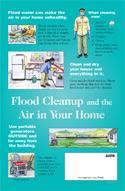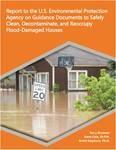Flood Cleanup to Protect Indoor Air Quality
Información disponible en español
Share your feedback with us.
Floods/Flooding
Natural Disasters and Weather Emergencies
Quick Links:
Get current emergency notifications from the Federal Emergency Management Agency, Hurricane Response and Recovery
Read the Centers for Disease Control and Prevention's (CDC) Emergency Preparedness and Response page on Natural Disasters and Severe Weather
During a flood cleanup, the indoor air quality in your home or office may appear to be the least of your problems. However, failure to remove contaminated materials and to reduce moisture and humidity can present serious long-term health risks. Standing water and wet materials are a breeding ground for microorganisms, such as viruses, bacteria and mold. They can cause disease, trigger allergic reactions and continue to damage materials long after the flood.
On This Page:
- Publications
- Fact Sheets
- Webinars
- Replacing Your Flooring after a Flood
- Additional Information about Floods
On Other Pages:
Publications
For basic information on how to clean up after a flood and how to prevent indoor air problems:
For information on ordering the following publications, visit EPA's National Service Center for Environmental Publications (NSCEP).
Flood Cleanup and the Air In Your Home: Booklet

This 28 page booklet prints in landscape as a 15 page printout. Please set your printer to landscape before printing.
The booklet is available in three languages:
English Version EPA 402-K-07-002
Vietnamese Version EPA 402-K-06-006-VIE
Spanish Version
Flood Cleanup and the Air In Your Home: Poster

The poster is available in three languages:
English Version (EPA 402-H-07-001)
Vietnamese Version (EPA 402-H-06-001)
Spanish Version (EPA 402-H-06-002)
Technical Report on Flood-Related Cleaning

This document addresses strategies for safely returning flooded buildings to habitable conditions after a hurricane or other weather event. It is is a technical summary of existing research and guidance on health hazards from floods, flood damage, and cleanup activities. EPA’s Indoor Environments Division commissioned the report; however, it does not necessarily represent EPA policy.
Fact Sheets
Flood Cleanup - Protecting Indoor Air Quality

This fact sheet contains basic information on flood cleanup with illustrations and links to more detailed information
Flood Cleanup Webinars
Flood Cleanup Webinar Presented by Dr. Gene Cole
This is a recording of the July 16, 2018, technical assistance webinar “Flood Cleanup” featuring Dr. Gene Cole and hosted by EPA’s Indoor Environments Division. Dr. Cole addressed many flood-related issues, including: specific remediation requirements for various types of water damage; use of biocides and personal protective equipment; best methods to reduce health and safety risks; and how to determine when remediation is complete.
Replacing Your Flooring after a Flood
If you are repairing your home or building after a flood or hurricane, to prevent mold growth you should be sure your foundation is dry before you replace the flooring. The American Society for Testing and Materials (ASTM) issued a standard which describes an easy way to check if your concrete slab is dry enough to replace the flooring. The basic approach is to fasten the edges of a clear piece of plastic sheeting to a concrete slab, and wait for approximately 16 hours. If moisture is visible on the plastic sheeting, it is still too wet to replace the flooring. For more details, visit the ASTM's portal for standard, testing, learning and more
Additional Information about Floods
- EPA's Webpage about Hurricanes and Flooding
- Information from the Centers for Disease Control and Prevention (CDC)
- Federal Emergency Management Agency (FEMA)
(800) 480-2520 - See Flood Information
- EPA's Office of Children’s Health - in the Aftermath of Floods
